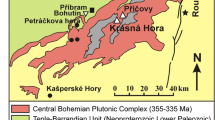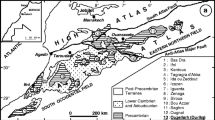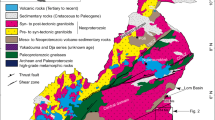Abstract—
The limited literature data on gold-bearing albite–pyroxene rodingites are summarized for the Agardag ultramafic massif in southern Tuva. These data are supplemented by new mineralogical, geochemical, thermobarogeochemical, and isotopic–geochemical results in order to reveal the physicochemical mineral formation conditions and sources of ore matter and fluids on gold deposition in rodingites. Rodingites and associated schistose nephritoids are near-fault metasomatites and are confined to a latitudinal tectonic zone in antigorite serpentinites. They formed in two stages. Stage I minerals (pyroxene, albite, etc.) are rodingites and stage II minerals (Na-bearing actinolite, albite, etc.) are nephritoids and veinlets that intersect rodingites. Disseminated sulfides of the Cu–S series (chalcocite, digenite, etc.) and Au minerals (tetra-auricupride and electrum) were deposited during both stages. The temperature regime (500–250°C) and low amount of CO2 in fluid (\({{{\text{X}}}_{{{\text{C}}{{{\text{O}}}_{{\text{2}}}}}}}\) = 0.017–0.025) correspond to the formation conditions of typical bimetasomatic rodingites. The degree of oxidation of gas components in fluids CO2/(CO2 + Σreduced gases) increases from rodingites (0.189) to nephritoids (0.299) and antigorite serpentinites (0.738). The O isotopic composition of silicates and calculated O isotopic composition of the fluid during antigorite serpentinization (5.8 to 7.6‰ δ18Оfl and –66 to –69‰ δDfl) correspond to juvenile and magmatic water in contrast to metamorphic water during nephritization and rodingitization (6 to 9.9‰ δ18Оfl and –39 to –46‰ δDfl) with involvement of heavy oxygen that was subjected to the sedimentary cycle. It is suggested that the magmatic ore-bearing fluid (7.3–7.6 wt % NaCl-equiv) separated from gabbroic melts. The oxidized fluid was modified to a reduced fluid during interaction with ultramafic rocks. The mafic and ultramafic rocks were the source of Na, REE, Au, Ag, Cu, and Ni. Deformations with the formation of veins and filling of veinlets are favorable for a high local gold concentration.











Similar content being viewed by others
REFERENCES
Agafonov, L.V., Lkhamsuren, Zh., Kuzhuget, K.S., and Oidup, Ch.K., Platinonosnost’ ul’tramafit–mafitov Mongolii i Tuvy (Platinum Potential of Mafic-Ultramafic Rocks of Mongolia and Tuva), Ulaanbaatar: Mongol’skii gosudarstvennyi universitet nauki i tekhnologii, 2005.
Beaudoin, G. and Therrien, P., The updated web stable isotope fractionation calculator, Handbook of Stable Isotope Analytical Techniques, (Elsevier, 2009), vol. 2, pp. 1120–1122.
Berzon, R.O., Zolotorudnye giperbazity (Gold-Bearing Ultramafic Rocks), Moscow: VIEMS, 1983.
Bodnar, R.J. and Vityk, M.O., Interpretation of microthermometric data for H2O–NaCl fluid inclusions, Fluid Inclusions in Minerals: Methods and Applications, Benedetto De Vivo and Frezzotti, Maria Luce, Eds., Pontignano-Siena, 1994, pp. 117–130.
Borisenko, A.S., Cryometric study of salt composition of gas–liquid inclusions in minerals, Geol. Geofiz., 1997, no.8, pp. 16–27.
Bortnikov, N.S., Volkov, A.V., Galyamov, A.L., Vikent’ev, I.V., Aristov V.V., Lalomov, A.V., and Murashov, K.Yu., Mineral resources of high-tech metals in Russia: State of the art and outlook, Geol. Ore Deposits, 2016, vol. 58, no. 2, pp. 83–103. https://doi.org/10.7868/S0016777016020027
Bryanchaninova, N.I., Dubinina, E.O., and Makeev, A.B., Hydrogen isotope geochemistry of chromite-bearing ultramafic rocks of the Urals, Dokl. Earth Sci., 2004, vol. 395A, no.3, pp. 359–363.
Chashchukhin, I.S. and Votyakov, S.L., Crystal chemistry of serpentine-group minerals as an indicator of early serpentinization in ultramafites: II. Serpentinization facies and sources of serpentinizing water, Geochem. Int., 2005, vol. 43, no.10, pp. 959–972.
Chashchukhin, I.S., Cherednichenko, N.V., and Adamovich, N.N., On the behavior of trace elements at early serpentinization of ultramafic rocks, Ezhegodnik–2011. Tr. IGG UrO RAN (A Yerbook-20110, Proc. Inst. geol. Geokhim. UrO RAN), Yekaterinburg: IGG UrO RAN, 2012, vol. 159, pp. 125–128.
Chudnenko, K.V. and Pal’yanova, G.A., Thermodynamic properties of soild solutions in the Au–Ag–Su system, Russ. Geol. Geophys., 2014, vol. 55, no.3, pp.349–360.
Coleman, R.G., Serpentinites, rodingites and tectonic inclusions in Alpine–type mountain chains, Spec. Pap., 1963, no. 73.
Damdinov, B.B., Zhmodik, S.M., Mironov, A.G., and Ochirov, Yu.Ch., Noble-metal mineralization in rodingites of the southeastern East Sayan, Russ. Geol. Geophys., 2004, vol. 45, no.5, pp. 536–546.
Faure, G., Principles of Isotope Geology, New York: Wileys, 1986.
Goncharenko, A.I., Deformatsiya i petrostrukturnaya evolyutsiya al’pinotipnykh giperbazitov (Deformation and Petrostructural Evolution of Alpine-Type Ultramafic Rocks), Tomsk: Tomsk. Univ., 1989.
Gorelova, N.N., Manifetsations of local metasomatism and relation of ore mineralization with it at one of ultramafic massifs of the Koryak highland, Izv. Vyssh. Uchebn. Zaved.,Geol. Geofiz., 1990, no.2, pp. 73–78.
O’Hanley, D.S., Schandl, E.S., and Wicks, F.J., The origin of rodingites from Cassiar, British Columbia, and their use to estimate T and P(H2O) during serpentinization, Geochim. Cosmochim. Acta, 1992, vol. 56, no. 1, pp. 97–108.
Ignat’ev, A.V. and Velivetskaya, T.A., Lazer method of water extraction from OH-minerals for measurement of hydrogen isotope composition, XVII Simpozium po geokhimii izotopov (17th Symposium on Isotope geochemistry), Moscow: GEOKhI RAN, 2004, pp. 98–99.
Izokh, A.E., Vladimirov, A.G., and Stupakov, S.I., Magmatism of the Agardag suture zone, Southeastern Tuva, Geologo–petrostrukturnye issledovaniya Yugo-Vostochnoi Tuvy (Geological–Petrostructural Studies of Southestern Tuva), Novosibirsk, 1988, pp. 19–75.
Hoefs, G., Stable Isotope Geochemistry, Berlin: Springer Verlag, 1983.
Klein, F., Bach, W., Jons, N., McCollom, T., Moskowitz, B., and Berqu, T., Iron partitioning and hydrogen generation during serpentinization of abyssal peridotites from 15oN on the Mid–Atlantic Ridge, Geochim. Cosmochim. Acta, 2009, vol. 73, pp. 6868–6893. https://doi.org/10.1016/j.gca.2009.08.021
Knight, J. and Leitch, C.H.B., Phase relations in the system Au–Cu–Ag at low temperatures, based on natural assemblages, Can. Mineral., 2001, vol. 39, pp. 889–905.
Knipe, S.W. and Fleet, M.E., Gold–copper alloy minerals from the Kerr Mine, Ontario, Can. Mineral., 1997, vol. 35, pp. 573–586.
Kolonin, G.R., Physicochemical properties of europium as a possible marker of mineral formation conditions, Dokl. Earth Sci., 2006, vol. 408, no. 4, pp. 649–651.
Kozakov, I.K., Kovach, V.P., Yarmolyuk, V.V., Kotov, A.B., Sal’nikova, E.B., and Zagornaya, N.Yu., Crust-forming processes in the geologic development of the Tuva–Mongolia massif: Sm-Nd isotopic and geochemical data for granitoids, Petrology, 2003, vol. 11, no.5, pp. 444–463.
Kudryavtseva, A.I. and Kudryavtsev, V.I., Manifestation of cupriferous and argentic gold in noble-metal mineralization of the South Tuva ultramafic belt, Sostoyanie i osvoenie prirodnykh resursov Tuvy i sopredel’nykh regionov Tsentral’noi Azii. Geoekologiya prirodnoi sredy i obshchestva (State and Development of Natural Resources of Tuva and Adjacent Regions of Central Asia. Geoecology of Natural Environment and Community), Kyzyl: TuvIKOPR SO RAN, 2003, pp. 45–48.
Leblanc, M. and Lbouabi, M., Native silver mineralization along a rodingite tectonic contact between serpentinite and quartz diorite (Bou Azzer, Morocco), Econ. Geol., 1988, vol. 83, pp. 1379–1391.
Lesnov, F.P., Redkozemel’nye elementy v ul’tramafitovykh i mafitovykh porodakh i ikh mineralakh. Kniga 1. Glavnye tipy porod. Porodoobrazuyushchie mineral (Rare-Earth Elements in Ultramafic and Mafic Rocks and their Minerals. Book 1. Major Rock Types. Rock-Forming Mineral), Novosibirsk: “GEO”, 2007.
Letnikov, F.A., Inversion of fluid systems in magmatic process, Flyuidy v magmaticheskikh protsessakh (Fluids in Magmatic Processes), Moscow: Nauka, 1982, pp. 242–253.
Lozhechkin, M.P., New data on the chemical composition of cupriferous gold, Dokl. Akad. Nauk SSSR, 1939, vol. 24, no. 5, pp. 454–457.
McCollom, T.M. and Bach, W., Thermodynamic constraints on hydrogen generation during serpentinization of ultramafic rocks, Geochim. Cosmochim. Acta, 2009, vol. 73, pp. 856–875. https://doi.org/10.1016/j.gca.2008.10.032
Molchanov, B., P., Plyusnina, L.P., Khanchuk, A.I., Zimin, C.S., Oktyabr’skii, R.A., Platinum- and gold-bearing rodingites of the Ust’-Dep ophiolite block (Middle Amur region), Dokl. Earth Sci., 2006, vol. 407, no. 2, pp. 250–253.
Murzin, V.V. and Sustavov, S.G., Soild-phase transformation in the natural cupriferous gold, Izv. Akad. Nauk SSSR, Ser. Geol., 1989, no.11, pp.94–104.
Murzin, V.V., Kudryavtsev, V.I., Berzon, R.O., and Sustavov, S.G., Cupriferous gold in rodingitization zones, Geol. Rudn. Mestorozhd., 1987, no.5, pp. 96–99.
Murzin, V.V., Sazonov, V.N., Varlamov, D.A., and Shanina, S.N., Gold mineralization in rodingites of the Alpine-type ultramafic massifs, Litosfera, 2006, no. 1, pp. 113–134.
Murzin, V.V., Oydup, Ch.K., and Varlamov, D.A., New finding of Cu–Au alloy in association with rodingite minerals in the Kaa–Khem ophiolitic belt, Tuva, Geol. Ore Deposits, 2009, vol. 51, no. 8, pp. 784–793. https://doi.org/10.1134/S107570150908011X
Murzin, V.V., Varlamov, D.A., Ronkin, Yu.L., and Shanina, S.N, Origin of Au-bearing rodingite in the Karabash Massif of alpine-type ultramafic rocks in the Southern Urals, Geol. Ore Deposits, 2013, vol. 55, no.4, pp. 278–297. https://doi.org/10.7868/S0016777013040059
Murzin, V.V., Chudnenko, K.V., Palyanova, G.A., Varlamov, D.A., Naumov, E.A., and Pirajno, F., Physicochemical model of formation of Cu–Ag–Au–Hg solid solutions and intermetallic alloys in the rodingites of the Zolotaya Gora gold deposit (Urals, Russia), Ore Geol. Rev., 2018, vol. 93, pp. 81–97. https://doi.org/10.1016/j.oregeorev.2017.12.018
Nikitchin, P.A., On question of geological structure and chromite potential of the Agardag ultramafic massif, Materialy po geologii Tuvinskoi ASSR (Proceedings on Geology of the Tuva ASSR), Kyzyl: Tuv. kn. Izd., 1969, vol. 1, pp. 43–47.
Oidup, Ch.K. and Kuzhuget, K.S., On the genesis of rodingites of the Agardag ultramafic massif, Giperbazitovye assotsiatsii skladchatykh oblastei. Petrokhimiya, mineralogiya, geokhimiya (Ultramafic Associations of Fold Systems. Petrochemistry, Mineralogy, and Geochemistry), Novosibirsk: IgiG SO AN SSSR, 1989, vol. 5, pp.100–111.
Pal’yanova G.A., Murzin V.V., Zhuravkova T.V., and Varlamov D.A., Au–Cu–Ag mineralization in rodingites and nepohritoids of the Agardag ultramafic massif (southern Tuva, Russia), Russ. Geol. Geophys., 2018, vol. 59, no.3, pp. 238–256. https://doi.org/10.15372/GiG20180303
Perevoznikova, E.V. and Kazachenko, V.T., First find of rodingites with gold–palladium–platinum mineralization in Sikhote–Aline, Litosfera, 2017, no.5, pp. 127–146. https://doi.org/10.24930/168190042017175127146
Plyusnina, L. P., Likhoidov, G. G., and Kuz’mina, T. V., Gold and fluid mode of listwaenitization, Litosfera, 2009, no. 5, pp. 85–90.
Plyusnina, L.P., Likhoidov, G.G., Molchanov, V.P., and Shcheka, Zh.A., Modeling of Gold mass transfer during the listwanitization and rodingitization using the example of the Ust’-Dep ophiolite complex in the Upper Amur Territory, Russ. J. Pac. Geol., 2007, vol. 1, no.5, pp. 464–472.
Plyusnina, L.P., Likhoidov, G.G., and Nekrasov, I.Ya., Gold solubility under conditions of interaction of chemically contrasting rocks with aqueous–chloride solutions at 500oC and 1 kbar, Dokl. Akad. Nauk, 1994, vol. 336, no.6, pp. 817–819.
Plyusnina, L.P., Likhoidov, G.G., and Zaraisky, G.P., Physicochemical conditions of rodingite formation: experimental data, Petrologiya, 1993, vol. 1, no.5, pp. 557–568.
Rechkin, A.N., On new type of gold mineralization in the ultramafic rocks, Geol. Geofiz., 1974, no.2, pp. 49–53.
Sazonov, V.N., Murzin, V.V., Ogorodnikov, V.N., and Volchenko, Yu.A., Gold mineralization associated with alpine-type ultramafic rocks, Litosfera, 2002, no.4, pp. 63–77.
Sekerin, A.P., Petrology of rodingites of the Sayan–Baikal Mountainous Area, Dokl. Akad. Nauk SSSR, 1982, vol. 262, no. 1, pp. 175–177.
Sidorov, E.G., Sandimirova, E.I., Chubarov, V.M., Anikin, L.P., Ibragimova, E.K., and Antonov, A.V., Typomorphic features of gold from placer occurrences of the Ol’khovaya 1–ya River (Kamchatskii Mys, Eastern Kamchatka), Vestn. KRAUNTs. Nauki o Zemle, 2013, vol. 21, no.1, pp. 34–43.
Spiridonov, E.M. and Pletnev, P.A., Mestorozhdenie medistogo zolota Zolotaya Gora (o “zoloto-rodingitovoi” formatsii), (Zolotaya Gora Cupriferous Gold Deposit (on “gold–rodingite” formation), Moscow: Nauchnyi mir, 2002.
Taylor, H.P.Jp., The application of oxygen and hydrogen isotope studies to problems of hydrothermal alteration and ore deposition, Econ. Geol., 1974, vol. 69, pp. 843–883.
Pfander, J.A., Jochum, K.P., Kroner, A., Kozakov, I., Oidup, C., and Todt W., Age and geochemical evolution of an early Cambrian ophiolite-island arc system in Tuva, South Central Asia, Generation and Emplacement of Ophiolites through Time, Geol. Surv. Finland. Spec. Pap., 1998, pp. 26–42.
Velinskii, V.V., Oidup, Ch.K., Kuzhuget, K.S., and Lebedev, V.I., Accessory minerals of mafic—ultramafic complexes of East Tuva, Zap. Ross. Mineral. O-va, 1999, no.4, pp.1–10.
Vladimirov, V.G., Vladimirov, A.G., and Gibsher, A.S., Model of the tectonometamorphic evolution for the Sangilen Block (southeastern Tuva, Central Asia) as a reflection of the Early Caledonian accretion–collision tectogenesis, Dokl. Earth Sci., 2005, vol. 405, no.1, pp. 1159–1165.
Yurkova, R.M. and Voronin, B.I., Gold mineralization in rodingites, Problemy geologii rudnykh mestorozhdenii, mineralogii, petrologii i geokhimii: Mater. nauch. konf., posvyashch. 100–letiyu so dnya rozhdeniya akademika F.V.Chukhrova (Problems of Geology of Ore Deposits, Mineralogy, Petrology, and Geochemistry. Conference Deedicated to the 100th Anniversary of Academician F.V. Chukhrov), Moscow: IGEM RAN, 2008, pp. 377–380.
ACKNOWLEDGMENTS
We are grateful to the discoverers of the Agardag occurrence A.I. Kudryavtseva and V.I. Kudryavtsev for shared collection of rock and ore samples, as well as unpublished materials.
Funding
This study was supported by the State Contract of IGG UB RAS, IGM SB RAS, and IEM RAS (project nos. АААА-А18-118052590028-9, № 0330-2016-0001, and АААА-А18-118020590151-3) and the Russian Foundation for Basic Research (project no. 16-05-00407a).
Author information
Authors and Affiliations
Corresponding authors
Ethics declarations
The authors declare that they have no conflict of interest.
Additional information
Translated by I. Melekestseva
Rights and permissions
About this article
Cite this article
Murzin, V.V., Palyanova, G.A., Varlamov, D.A. et al. Gold-Bearing Rodingites of the Agardag Ultramafic Massif (South Tuva, Russia) and Problems of Their Genesis. Geol. Ore Deposits 62, 204–224 (2020). https://doi.org/10.1134/S107570152002004X
Received:
Revised:
Accepted:
Published:
Issue Date:
DOI: https://doi.org/10.1134/S107570152002004X




